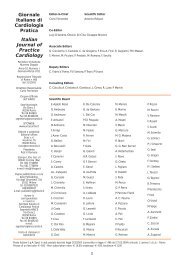Scarica il documento in formato pdf (556 KB) - ANCE
Scarica il documento in formato pdf (556 KB) - ANCE
Scarica il documento in formato pdf (556 KB) - ANCE
Create successful ePaper yourself
Turn your PDF publications into a flip-book with our unique Google optimized e-Paper software.
Le disfunzioni del nodo del seno e la s<strong>in</strong>drome<br />
bradi-tachicardia: aspetti cl<strong>in</strong>ici, diagnosi<br />
elettrocardiografica e strategie terapeutiche<br />
Sick s<strong>in</strong>us syndrome and brady-tachy syndrome.<br />
Cl<strong>in</strong>ical aspects, ECG diagnosis and therapeutic<br />
strategies.<br />
C. D'Ascia*, S.L. D'Ascia<br />
La malattia del nodo del seno <strong>in</strong>clude numerose alterazioni che co<strong>in</strong>volgono la funzione di emergenza e propagazione degli<br />
impulsi al tessuto atriale e le proprietà elettriche dello stesso atrio. Le cause possono essere organiche o funzionali con<br />
<strong>in</strong>terventi patologici diretti o <strong>in</strong>diretti. Il danno anatomo-patologico più r<strong>il</strong>evante è rappresentato dalla sostituzione del tessuto<br />
normale con tessuto fibroso. Cl<strong>in</strong>icamente ciò comporta bradicardia, blocchi seno-atriali e alternanza di bradicardia con<br />
tachiaritmia e fibr<strong>il</strong>lazione atriale. La diagnosi, oltre che cl<strong>in</strong>icamente, si effettua con esami elettrocardiografici, specie con<br />
registrazione cont<strong>in</strong>ua o <strong>in</strong>termittente tipo Holter, nonché con studio elettrofisiologico. La terapia è strettamente <strong>in</strong>dividuale e<br />
spesso è necessario ricorrere a stimolazione atrioguidata con pac<strong>in</strong>g bicamerale. La terapia orale è basata su anticoagulanti<br />
ed aspir<strong>in</strong>a mentre raramente efficace può risultare la terapia con aritmici.<br />
The sick s<strong>in</strong>us syndrome (D.N.S.), <strong>in</strong>cludes numerous electrophysiological alterations that <strong>in</strong>volve both the <strong>in</strong>tr<strong>in</strong>sic function and the<br />
impulse conduction towards the surround<strong>in</strong>g atrial tissue and the conduction system, and the electrical properties of the atrium itself.<br />
They can be connected to organic or functional causes and affect the structures <strong>in</strong> a direct or <strong>in</strong>direct way; but, ma<strong>in</strong>ly, is a seno-atrial<br />
tissue fibrousis the most visible process <strong>in</strong> the region architectonic upsett<strong>in</strong>g: it is related to male sex and to old age people.<br />
Cl<strong>in</strong>ically and electrocardiographically it <strong>in</strong>cludes several pathologies characterized by bradycardia or chronotropic <strong>in</strong>competence,<br />
by seno-atrial blocks and a brady-tachy syndrome, that is characterized by the bradycardia and by different forms of<br />
tachyarhythmias alternation, and by the atrial fibr<strong>il</strong>lation as well. The cl<strong>in</strong>ical picture can be a much variable one, and pass from<br />
asymptomatic to general neurological disturbs, up to serious thromboembolism disturbs both peripheral and central. The diagnostic<br />
documentation is <strong>in</strong>dispensable, especially the ecocardiographical one, that <strong>in</strong> many cases can be only obta<strong>in</strong>ed through cont<strong>in</strong>uous<br />
registration methods such as Holter, or <strong>in</strong>termittent registrations of events; an <strong>in</strong>vasive method (electrophysiological study) is rarely<br />
necessary for the pathology documented demonstration. The treatment strategies can differ from patient to patient, due to the<br />
variab<strong>il</strong>ity of the possible pathologies, but the so frequent presence of bradyarhythmias often leads to the treatment, <strong>in</strong> a successfull<br />
way, through the atrioventricular bicameral pac<strong>in</strong>g, accord<strong>in</strong>g to the guide l<strong>in</strong>es. Q1 Essential, and widely demonstrated by now,<br />
the anticoagulant treatment benefits, both for aspir<strong>in</strong> and placebo. Completely useless, on the other hand, the medications, often<br />
more harmful than effective. An eye must go to the new AF methodical approach as well, through the radiofrequency transcatheter<br />
ablation, and to the pace–makers algorithms dedicated to its prevention, <strong>in</strong> cases <strong>in</strong> which the prem<strong>in</strong>ent DNS component is the AF.<br />
(It J Practice Cardiol 2003;1:49-58)<br />
Key words: sick s<strong>in</strong>us syndrome • brady-tachy syndrome<br />
© 2003 <strong>ANCE</strong> Ricevuto <strong>il</strong> 10 luglio 2003; accettato <strong>il</strong> 14 novembre 2003.<br />
*Dirigente settore funzionale di aritmologia, Dipartimento Scienze Cardiologiche, Università Federico II Napoli<br />
Correspond<strong>in</strong>g author: C. D'Ascia<br />
Tel./Fax 080 7463075, Cell. 348 3315470, E-ma<strong>il</strong> crisdas@virg<strong>il</strong>io.it<br />
It J Practice Cardiol is ava<strong>il</strong>able at http://www.ancecardio.it<br />
Il concetto di Malattia del nodo del seno o<br />
Disfunzione del nodo del seno o Sick s<strong>in</strong>us<br />
syndrome (DNS), <strong>in</strong>teso come s<strong>in</strong>drome<br />
cl<strong>in</strong>ica, è piuttosto recente e si deve,<br />
<strong>in</strong>torno agli anni Sessanta, a Lown (1)<br />
che descrisse la presenza di un ritmo atriale<br />
caotico che spesso seguiva una cardioversione<br />
elettrica per fibr<strong>il</strong>lazione atriale<br />
(FA) e, successivamente a Ferrer che sottol<strong>in</strong>eò<br />
la presenza simultanea di bradicardia<br />
49
















